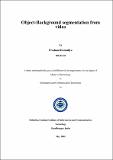Please use this identifier to cite or link to this item:
http://drsr.daiict.ac.in//handle/123456789/559| Title: | Object-background segmentation from video |
| Authors: | Mitra, Suman K. Domadiya, Prashant |
| Keywords: | Video segmentation Video Object Segmentation Change Detection object compression Video surveillance Video compression Digital video Image processing Digital techniques |
| Issue Date: | 2015 |
| Publisher: | Dhirubhai Ambani Institute of Information and Communication Technology |
| Citation: | Domadiya, Prashant (2015). Object-background segmentation from video. Dhirubhai Ambani Institute of Information and Communication Technology, xi, 53 p. (Acc.No: T00522) |
| Abstract: | Fast and accurate algorithms for background-foreground separation are an essential part of <p/>any video surveillance system. GMM (Gaussian Mixture Models) based object segmentation <p/>methods give accurate results for background-foreground separation problems but are <p/>computationally expensive. In contrast, modeling with only single Gaussian improves the <p/>time complexity with the reduction in the accuracy due to variations in illumination and <p/>dynamic nature of the background. It is observed that these variations affect only a few <p/>pixels in an image. Most of the background pixels are unimodal. We propose a method <p/>to account for the dynamic nature of the background and low lighting conditions. It is an <p/>adaptive approach where each pixel is modeled as either unimodal Gaussian or multimodal <p/>Gaussians. The flexibility in terms of number of Gaussians used to model each pixel, along <p/>with learning when it is required approach reduces the time complexity of the algorithm <p/>significantly. To resolve problems related to false negative due to the homogeneity of color <p/>and texture in foreground and background, a spatial smoothing is carried out by K-means, <p/>which improves the overall accuracy of proposed algorithm. The shadow causes the problem <p/>in many applications which rely on segmentation results. Shadow cause variation in <p/>RGB values of pixels, RGB value dependent GMM based method can’t remove shadow <p/>from detection results. The preprocessing stage involving illumination invariant representation <p/>takes care of the object shadow as well. |
| URI: | http://drsr.daiict.ac.in/handle/123456789/559 |
| Appears in Collections: | M Tech Dissertations |
Files in This Item:
| File | Description | Size | Format | |
|---|---|---|---|---|
| 201311028.pdf Restricted Access | 3.07 MB | Adobe PDF |  View/Open Request a copy |
Items in DSpace are protected by copyright, with all rights reserved, unless otherwise indicated.
